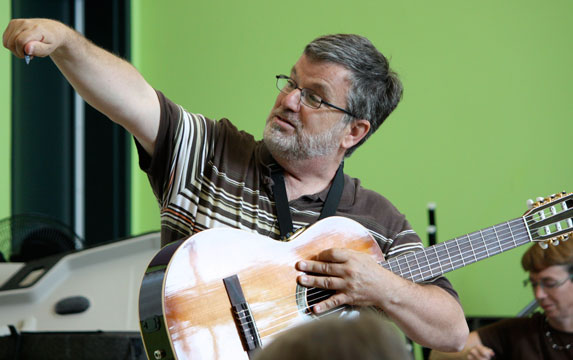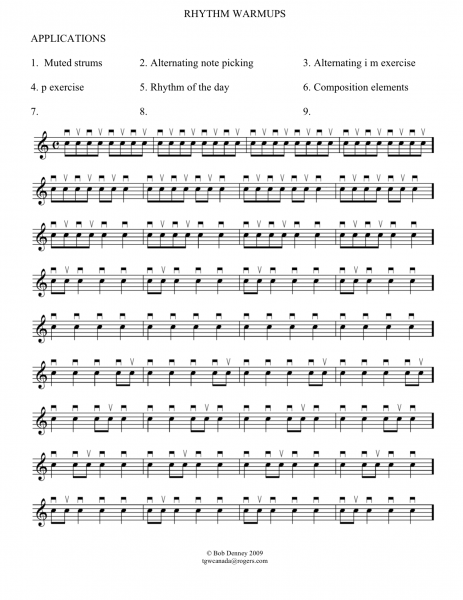 All guitar players are rhythm guitarists. The guitar has always been included as a key member of the rhythm section. Freddie Green, Chuck Berry, John Lennon and Keith Richards are/were self-described “rhythm guitarists”. It doesn’t matter how many notes you play or how fast you can play them, if you can’t perform “in time”.
All guitar players are rhythm guitarists. The guitar has always been included as a key member of the rhythm section. Freddie Green, Chuck Berry, John Lennon and Keith Richards are/were self-described “rhythm guitarists”. It doesn’t matter how many notes you play or how fast you can play them, if you can’t perform “in time”.
Audiences may not always hear the “wrong” notes you play … “really I was just playing outside the changes for effect!”, but they will hear and feel the impact of poorly played rhythm. By isolating and working on rhythm techniques you can assist students in becoming solid performers.
Beginning each class with rhythm warm-ups is a great way to not only turn on hands but also minds. When the students get to the point that they have internalized simple rhythms they are free to focus on other aspects of playing.
Here is how I present rhythm using the rhythm sheet accompanying this article.
1. Project or write the rhythms on the board. With no music stand in front of them, you can see the students’ hands and even more critically, you can make sure their eyes are on the music.
2. Have them count out loud as they play. This ensures they are using their eyes and not just their ears.
3. After the last strum is played they must raise their pick above their head in a “big rock finish” pose. Again, this helps to ensure they are reading.
While a lot of method books start with quarter notes, the fundamental motion of strumming involves up and down movement. After becoming comfortable with line 1, then it is simply a manner of coaching the students to “miss” the strings when coming back up when the quarter note is introduced. Repetition is another key element. These rhythms are not overly challenging so I find ways to “trick” the kids into as many repetitions as I can. While they are in their “big rock finish” pose I shout out new instructions: “We have to do it again because somebody missed the finish or somebody wasn’t counting out loud or this time the girls play the quarter notes and the guys play the eighth notes or if your phone number ends in an odd number play the eighths etc. Use your imagination, keep it fast moving and make it fun.
I’ve included some examples of alternate ways of using the rhythm sheet and left space for you to include your own. My classes may use a line as the Rhythm of the Day which we apply to a new chord progression or scale pattern. The rhythms can be utilized as a resource for composition activities. When the appropriate time comes around I make a sheet of syncopated patterns, dotted patterns or rhythms based on our repertoire.
The principle of teaching only one new concept at a time is critical for success. Rhythm warm-ups can be a comfortable and musical base to learn and apply new skills and techniques.
Download these rhythm warmups: Denney: Rhythm Warmups
[social_button button=”facebook” furl=”http://www.facebook.com/pages/Teaching-Guitar-Workshops/98983006090?ref=ts&fref=ts” flayout=”standard ” fwidth=”450″ faction=”like” fcolorsheme=”light”]
